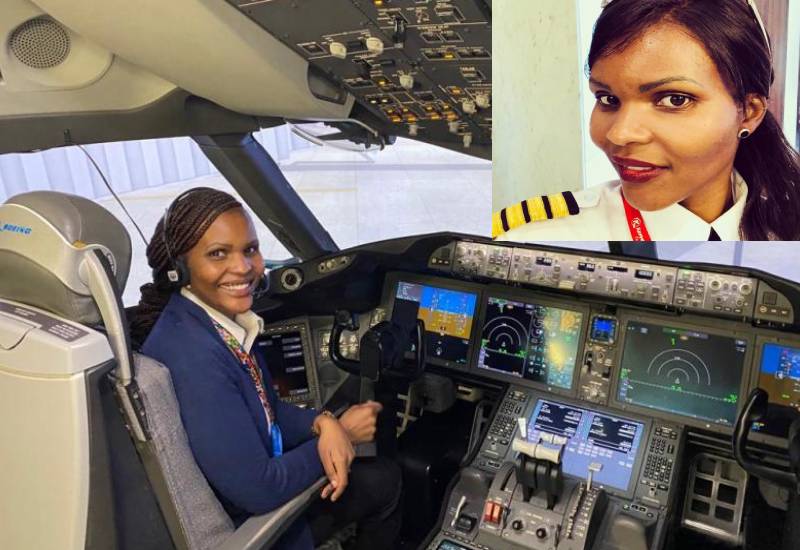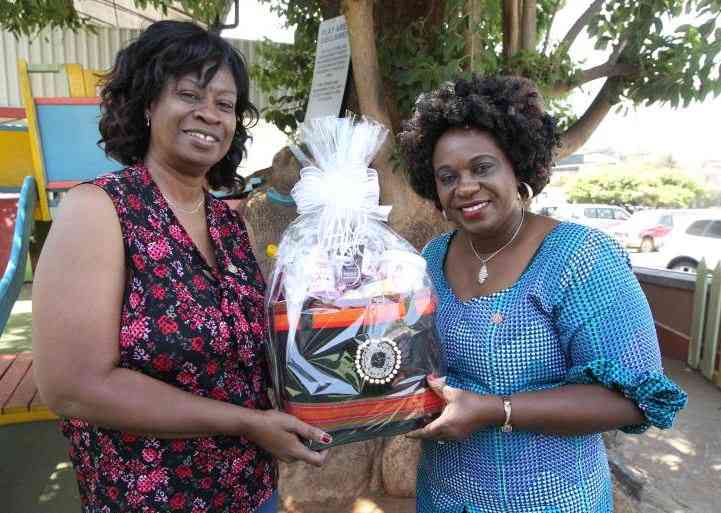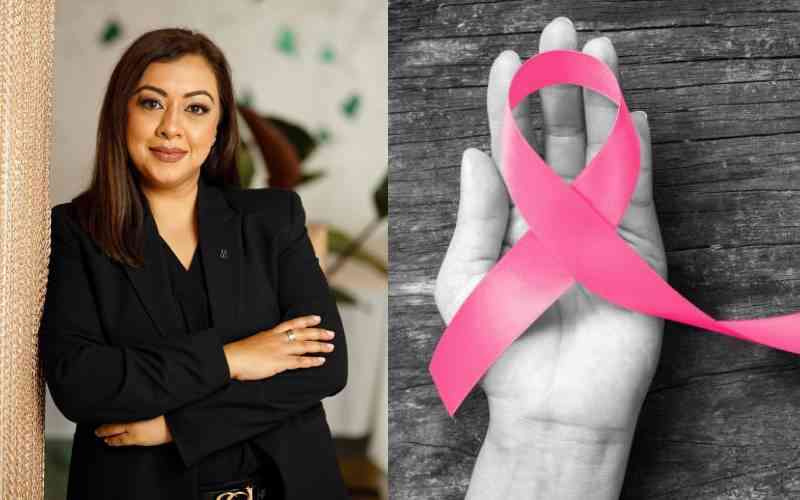
After months of waiting, we finally get an interview with Captain Ruth Karauri, the Kenyan pilot with a magic touch.
She has been on the news yet her big story has remained untold since she dazzled the world with her skilful landing at Heathrow Airport, London, following a raging storm.
The lighting in her Kitusuru home is perfect, with the soft morning rays bouncing off her white walls to reflect beautifully on her skin. Meanwhile, I have to employ some ring rights to get the same effect.
Of course, my first question is the incident that threw her into the limelight; battling Storm Eunice.
But just before she answers, we are interrupted by her youngest, Nia, who is turning two at the end of the month. May 28, to be exact. She says hi, and adds that her name is Nia Nkirote before she is taken away by Neema, the house manager, albeit reluctantly.
She straightens her hair and we chat a bit about how not many people recognise that Karauri is a Meru name, and she is surprised I figured that right off the bat.
Many know Ruth for her ‘skillful’ near-perfect crosswind landing on February 18 in London’s Heathrow Airport during the storm christened Storm Eunice. It was at 4.01 pm.
“As skillful as people said it looked, it was a normal landing to me. The technique I used is one I apply daily, but to varying degrees depending on the strength of the wind,” she had explained through a recorded video that went viral.
With the winds up to 60 knots on that day, the landing technique really came to play.
“Wind speed is measured in knots. On a typical day, the most one would encounter were about 20 knots or 25 knots if it is really bad.” On this day she went viral, the winds were at 45 knots gusting to raging 60 knots, a wind magnitude you do not experience every day. This is where the skill really comes out.”
Crosswind limitation
To explain the landing technique she used, Ruth first describes the concept of winds. Each airplane has its own crosswind limitation, which is the maximum wind speed you can land with – that is dependent on the weather conditions.
“For the 787 which I fly, the crosswind limitation is 33 knots on a dry run (when the runway is dry), which is the limitation she was working on that day. Beyond that crosswind, you cannot attempt to land.”
“The crosswind does not have much effect during the cruise – while in the air. But when it comes to landing, a crosswind tends to push you off course. Therefore, for a proper landing, you put the nose into the wind, allowing the wind to push you off course, while in essence pushing you into the runway,” she says of the ‘skill’.
Besides, the crosswind, there is a headwind which is when the wind comes towards the nose of the plane, which is what you want when landing and during takeoff.
“When landing headwinds slow you down so you use a shorter landing distance while during takeoff, headwinds slow you down so you are using less runway to accelerate. This keeps you on the runway longer, allowing you to get to the rotation speed you need for takeoff,” she demonstrates, adding that a tailwind is a detriment during takeoff as it pushes you forward, allowing you to get to the end of the runway having not achieved the speed to lift off.
“A tailwind, which comes from behind the plane, is what you need during the cruise, to push you forward so you get to your destination faster saving on both fuel and time,” she says, making me think she would make a good teacher given her excellent explanations.

Alternative
She, however, reasons that the virality of the video was because “People wrongly assume the plane lands straight. Due to crosswind, you have to fly sideways and straighten the plane out on touchdown.
And seeing this technique applied up close – on video – and the fact that there was a storm, made the difference,” she says while demonstrating with the help of her model plane.
That, plus, “on the day I went viral for simply doing my job, the alternate airports where I could have landed, including Manchester, Paris and Amsterdam had called that morning saying they were not available for diversions seeing the storm was affecting most of Northern Europe.”
For this reason, she was more vigilant in her flying and had made considerations to carry more fuel in the event she was unable to land in London allowing her to wait in the air and see if the wind dies down before landing.
Go-arounds
This waiting in the air to see is called a go-around and could be caused by a number of issues, but commonly by weather. In her 20 years of flying, Ruth has experienced two go-arounds.
“The first time was due to low clouds. There is a certain height at which you should be able to see the runway since you manually land the plane, otherwise you go around. You then make a decision to wait until the fog clears or diverts. I opted to divert the Nairobi landing to Mombasa,” she says.
“In my second go around, there was an aircraft on the runway.” Other more interesting go-arounds experienced by her colleagues include birds, and dogs crossing the runway which is common in West Africa. She recalls a story of a man cycling across the runway, prompting a go-around.
Starting out
Her interest in flying started when in Class Two when she saw a Kenya Airways (KQ) advert on TV. “What caught my attention was the pilot’s uniform. I wanted to wear that uniform, especially the hat. At the time, I did not even know pilots flew planes.”
In high school, having conceptualised what flying was all about, Ruth discovered flying was not quite affordable.
But that did not stop her from dreaming. After completing high school (Alliance High School) and scoring an A, “I was called to Moi University to pursue a course in Electrical Engineering,”
In the two-year gap prior to joining university, KQ placed a call for an application advert in the newspaper for the Ab Initio Pilot Trainee Programme.
“I applied and qualified to be among the 15 from over 3,000 applicants, after three rounds of interviews. We were then flown to Addis Ababa for the 20-month training,” she says, wondering where she would be had she gone to Moi University.

Meeting Karauri
“I met my husband in flying school. The first time I saw him, he was wearing cream-coloured trousers and a blue shirt,” she remembers fondly.
“My first impression of him was that he was a gentleman. He was walking ahead of me and when he got to the door he held the door open until I got there. That has stuck with me to date,” Ruth says, unsure whether this gentlemanly act meant she had never met a gentleman before, “but at 19, straight from high school, I do not think it would have taken much to impress me.”
“As he stood holding the door ajar, I wondered what he was waiting for,” she says of the only thing she recalls from their initial encounters.
Ronald Karauri is an aspiring MP for Kasarani Constituency.
His decision to run for office was also discussed between them, as it would change the family dynamics if elected.
“We felt it was time to stop sitting on the sidelines and blame everyone else when things go wrong. As Mahatma Gandhi put it, ‘be the change you want to see in the world.’”
First-off
As a matter of firsts, the 737 was the first jet aircraft, she ever flew as a first officer. Her first day was September 1, 2004.
“I flew the 737 for a year, then flew the 767 for two years, the 777 for three years before I became a captain in the 736. Before flying a different kind of aircraft, you have to undergo a six-week conversion training to acclimatise yourself with the particular aircraft system,” says Ruth.
Of her most memorable flights, “my first flight as a passenger, the flight to Addis Ababa for the training, my first flight in flying school and my first flight at KQ come to mind, my first solo flight (without the instructor). I, especially cherish these memories because they make me more appreciative and sensitive to first-time flyers who remind me I was there at one point.”
“My first flight as a captain was surreal. I was constantly looking at the instrumentation and the fuel and the weather. Usually, as a first officer, you rest knowing if anything goes wrong you can look to your left where the captain sits. As a captain, when you look to the left you see a window giving you a reflection of yourself. When we landed, it felt like I had been carrying the plane on my back, and only then did I relax,” she says of that night's flight to Accra.
Thriving in a male-dominated industry
The first time flying into Cotonou, Benin was notable. “They could not wrap their minds around seeing a female pilot. And seeing that female pilots make up less than 10 per cent, I understand their shock.”
“But that should not stop any girl from believing she can be whatever she sets her mind to,” Ruth advises young women keen on joining the aviation industry.
Once you have believed you can do it, she recommends you go for it. Going for it starts with letting your dream be known and asking questions.
“If I had not let my parents know I wanted to fly, I would probably have ended up an electrical engineer. It was my father who showed me the ab initio pilot advert. I do not know if he was on the lookout, actively trying to get me into flying school, but I was not looking to push him to pay the hefty flying school fees seeing there were others to be taken care of,” says Ruth who is the second of five siblings.
“I also appreciate the many questions I get from young people about getting into this industry, like which subjects would one should take in school to become a pilot or which flying school to attend – because just like any other schools, there are good and bad flying schools –, and financial help questions,” the pilot says, especially for women who need to go the extra mile.
Motherhood
With flying taking her away from home, I inquire how she balances between family and work. “There is no balance,” she gives as the short answer. “In my experience, if you try to balance, you have mediocrity on both ends. One thing has to suffer,” she says.
In her case, her work suffers, at least for now. If by suffering she means clocking 9,000 flying hours as opposed to 12,000, which the career-oriented pilots she was within the ab initio programme have managed, I too would not mind that kind of suffering. Flying hours is the measure of experience of a pilot.
“My decision to start a family cost me an average of 1,000 flying hours per child,” says the mum of three: Nathan, nine; Natalie, nine and Nia, two.
As she gets into her 40s, she cannot wait to see her children come into themselves.
Ruth hopes that when her children are grown up, and as she approaches her 50s, she will give more time to advance her career.
 The Standard Group Plc is a multi-media organization with investments in media platforms spanning newspaper print
operations, television, radio broadcasting, digital and online services. The Standard Group is recognized as a
leading multi-media house in Kenya with a key influence in matters of national and international interest.
The Standard Group Plc is a multi-media organization with investments in media platforms spanning newspaper print
operations, television, radio broadcasting, digital and online services. The Standard Group is recognized as a
leading multi-media house in Kenya with a key influence in matters of national and international interest.










